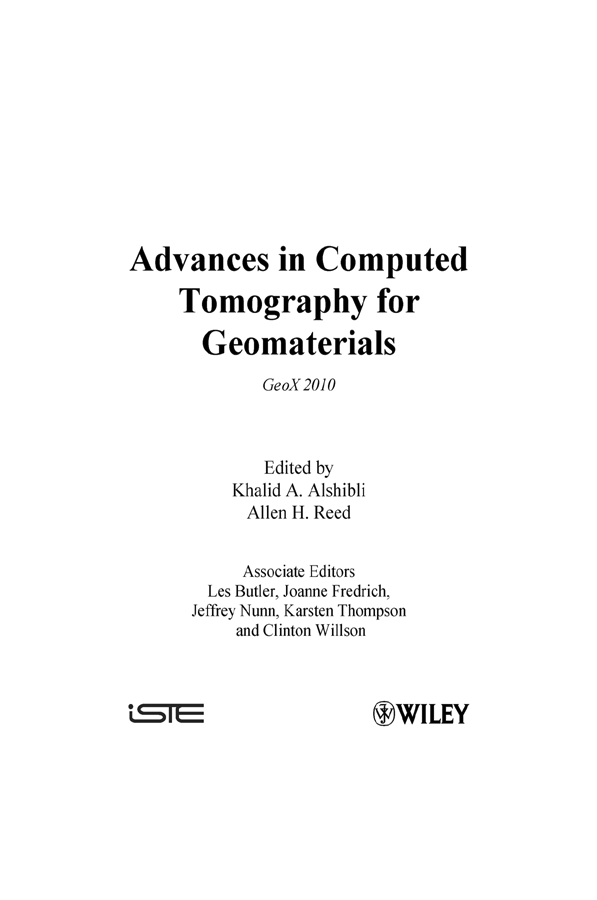 Title Page
by Allen H. Reed, Khalid A. Alshibli
Advances in Computed Tomography for Geomaterials: GeoX 2010
Title Page
by Allen H. Reed, Khalid A. Alshibli
Advances in Computed Tomography for Geomaterials: GeoX 2010
- Cover
- Title Page
- Copyright
- Organizing Committee
- International Advisory Committee
- Foreword
- Sand Deformation at the Grain Scale Quantified Through X-ray Imaging
- Quantitative Description of Grain Contacts in a Locked Sand
- 3D Characterization of Particle Interaction Using Synchrotron Microtomography
- Characterization of the Evolving Grain-Scale Structure in a Sand Deforming under Triaxial Compression
- Visualization of Strain Localization and Microstructures in Soils during Deformation Using Microfocus X-ray CT
- Determination of 3D Displacement Fields between X-ray Computed Tomography Images Using 3D Cross-Correlation
- Characterization of Shear and Compaction Bands in Sandstone Using X-ray Tomography and 3D Digital Image Correlation
- Deformation Characteristics of Tire Chips-Sand Mixture in Triaxial Compression Test by Using X-ray CT Scanning
- Strain Field Measurements in Sand under Triaxial Compression Using X-ray CT Data and Digital Image Correlation
- Latest Developments in 3D Analysis of Geomaterials by Morpho+
- Quantifying Particle Shape in 3D
- 3D Aggregate Evaluation Using Laser and X-ray Scanning
- Computation of Aggregate Contact Points, Orientation and Segregation in Asphalt Specimens Using their X-ray CT Images
- 1. Introduction
- 2. Materials and characteristics of the x-ray CT equipment
- 3. Image processing procedure to segment aggregates
- 4. Calculation of aggregate-to-aggregate contact points
- 5. Calculation of the orientation of aggregates
- 6. Calculation of the segregation of aggregates
- 7. Conclusions
- 8. References
- Integration of 3D Imaging and Discrete Element Modeling for Concrete Fracture Problems
- Application of Microfocus X-ray CT to Investigate the Frost-induced Damage Process in Cement-based Materials
- Evaluation of the Efficiency of Self-healing in Concrete by Means of µ-CT
- Quantification of Material Constitution in Concrete by X-ray CT Method
- Sealing Behavior of Fracture in Cementitious Material with Micro-Focus X-ray CT
- Extraction of Effective Cement Paste Diffusivities from X-ray Microtomography Scans
- Contributions of X-ray CT to the Characterization of Natural Building Stones and their Disintegration
- Characterization of Porous Media in Agent Transport Simulation
- Two Less-Used Applications of Petrophysical CT-Scanning
- Trends in CT-Scanning of Reservoir Rocks
- 3D Microanalysis of Geological Samples with High-Resolution Computed Tomography
- Combination of Laboratory Micro-CT and Micro-XRF on Geological Objects
- Quantification of Physical Properties of the Transitional Phenomena in Rock from X-ray CT Image Data
- Deformation in Fractured Argillaceous Rock under Seepage Flow Using X-ray CT and Digital Image Correlation
- Experimental Investigation of Rate Effects on Two-Phase Flow through Fractured Rocks Using X-ray Computed Tomography
- Micro-Petrophysical Experiments Via Tomography and Simulation
- Segmentation of Low-contrast Three-phase X-ray Computed Tomography Images of Porous Media
- X-ray Imaging of Fluid Flow in Capillary Imbibition Experiments
- Evaluating the Influence of Wall-Roughness on Fracture Transmissivity with CT Scanning and Flow Simulations
- In Situ Permeability Measurements inside Compaction Bands Using X-ray CT and Lattice Boltzmann Calculations
- Evaluation of Porosity in Geomaterials Treated with Biogrout Considering Partial Volume Effect
- Image-Based Pore-Scale Modeling Using the Finite Element Method
- Numerical Modeling of Complex Porous Media For Borehole Applications
- Characterization of Soil Erosion due to Infiltration into Capping Layers in Landfill
- On Pore Space Partitioning in Relation to Network Model Building for Fluid Flow Computation in Porous Media
- 3D and Geometric Information of the Pore Structure in Pressurized Clastic Sandstone
- Evaluation of Pressure-dependent Permeability in Rock by Means of the Tracer-aided X-ray CT
- Assessment of Time-Space Evolutions of Intertidal Flat Geo-Environments Using an Industrial X-ray CT Scanner
- Neutron Imaging Methods in Geoscience
- Progress Towards Neutron Tomography at the US Spallation Neutron Source
- Synchrotron X-ray Micro-Tomography and Geological CO2 Sequestration
- Residual CO2 Saturation Distributions in Rock Samples Measured by X-ray CT
- X-ray CT Imaging of Coal for Geologic Sequestration of Carbon Dioxide
- Comparison of X-ray CT and Discrete Element Method in the Evaluation of Tunnel Face Failure
- Plugging Mechanism of Open-Ended Piles
- Development of a Bending Test Apparatus for Quasi-dynamical Evaluation of a Clayey Soil Using X-ray CT Image Analysis
- Author Index
-
No Comment
..................Content has been hidden....................
You can't read the all page of ebook, please click here login for view all page.
